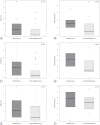Comparison of continuous local anaesthetic and systemic pain treatment after axillary lymphadenectomy in breast carcinoma patients - a prospective randomized study
- PMID: 23801911
- PMCID: PMC3691083
- DOI: 10.2478/raon-2013-0018
Comparison of continuous local anaesthetic and systemic pain treatment after axillary lymphadenectomy in breast carcinoma patients - a prospective randomized study
Abstract
Background: Acute pain after axillary lymphadenectomy is often related mainly to axillary surgery. The aim of the prospective randomized study was to find out if continuous wound infusion of local anaesthetic reduces postoperative pain, consumption of opioids and the incidence of chronic pain compared to the standard intravenous piritramide analgesia after axillary lymphadenectomy in breast carcinoma patients.
Methods: Altogether 60 patients were enrolled in the prospective randomized study; half in wound infusion of local anaesthetic and half in the standard (piritramide) group.
Results: In the recovery room and on the first day after surgical procedure, the wound infusion of local anaesthetic group reported less acute and chronic pain, a lower consumption of piritramide and metoclopramide, but their alertness after the surgical procedure was higher compared to the standard group.
Conclusions: After axillary lymphadenectomy in breast carcinoma patients, wound infusion of local anaesthetic reduces acute pain and enables reduced opioid consumption, resulting in less postoperative sedation and a reduced need for antiemetic drugs. After wound infusion of local anaesthetic there is a statistical trend for reduction of chronic pain.
Keywords: breast carcinoma; elastomeric pump; pain treatment; wound infusion of local anaesthetic.
Figures



References
-
- Merskey H, Bogduk N.editors Classification of chronic pain: descriptions of chronic pain syndromes and definitions of pain terms Second edition Seattle: IASP Press; 1994
-
- Talbot H, Hutchinson P, Edbrooke DL, Wrench I, Kohlhardt SR. Evaluation of a local anaesthesia regimen following mastectomy. Anaesthesia. 2004;59:664–7. - PubMed
-
- Katz J, Poleshuck EL, Andrus CH, Hogan LA, Jung BF, Kulick DI, et al. Risk factors for acute pain and its persistence following breast cancer surgery. Pain. 2005;119:16–25. - PubMed
-
- Almeida TF, Roizenblatt S, Tufik S. Afferent pain pathways: a neuroanatomical review. Brain Research. 2004;1000:40–56. - PubMed
-
- Schell SR. Patient outcome after axillary lymph node dissection for breast cancer: use of postoperative continuous local anaesthesia infusion. J Surg Res. 2006;134:124–32. - PubMed
LinkOut - more resources
Full Text Sources
Other Literature Sources
